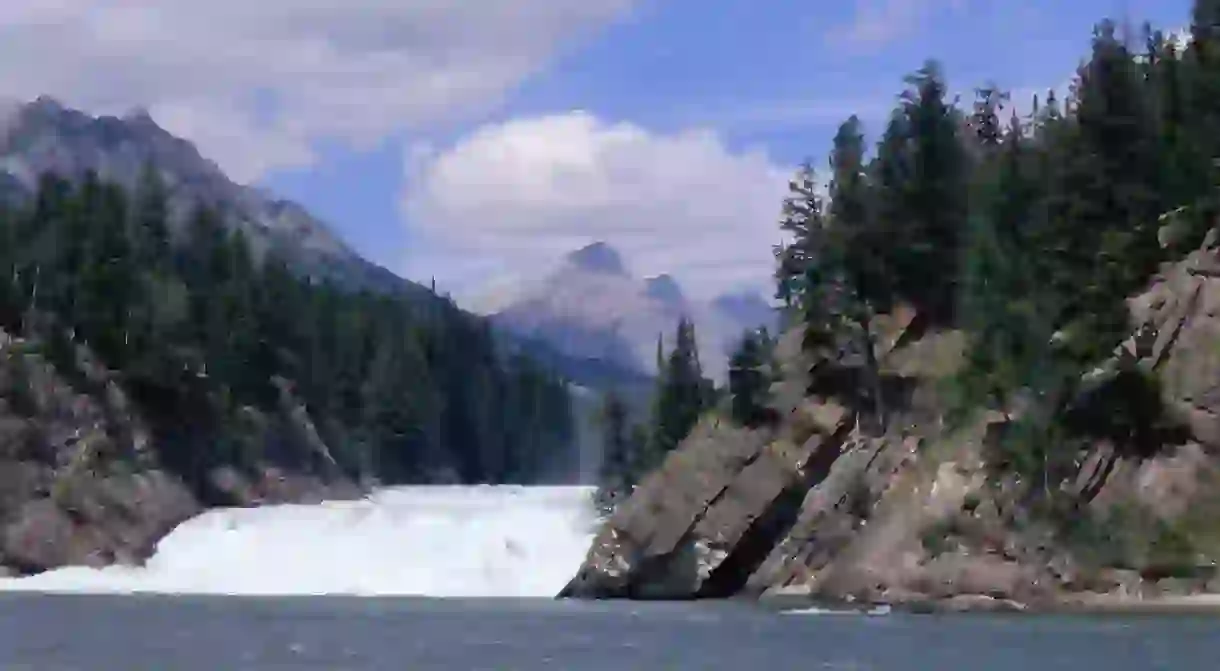The Most Beautiful Waterfalls in and Around Banff

Banff National Park is synonymous with snowy mountain peaks, avalanche chutes and waterfalls that may be frozen for half the year. As snow may fall on the Rockies all twelve months of the year, waterfalls and river volumes can change rapidly. Whether a thunderous flow or a gentle trickle, water plays an important role in the shaping of the mountains and the beauty of the environment.
Cascade Mountain
Natural Feature
Every brochure photograph of Banff includes a view down Banff Avenue framed by the mighty Cascade Mountain (9,836 ft/2,998 m) – the highest peak near the Town of Banff. Aptly named, Cascade has a prominent 950ft (290m) waterfall that can be easily seen from the highway. Climbers frequent this ice in the winter, and it is fairly easy to hike a short way up beside the chute during the warmer months. The waterfall is best viewed from the loop road to Lake Minnewanka.
Bow Falls
Natural Feature
Within the Banff Town boundaries, Bow Falls are simply a must and can be reached by foot, bike or car. The falls were made famous by Marilyn Monroe’s 1954 River of No Return. They are located on the Bow River, just below the Banff Springs Hotel. Water volumes change daily, and float trips depart from below the falls. Parks Canada maintain some useful info panels by the base of Bow Falls. For an alternate higher view, walk up Buffalo Street towards Surprise Corner.
Johnston Canyon
Natural Feature

Driving west from Banff Townsite, the old 1A highway leads to Johnston Canyon. This extremely popular hike will guide you to the Lower Falls (in about 30 mins) and the slightly less busy Upper Falls (in 30 minutes more). This is one of Banff’s most accessible trails, and it leads through the canyon. The route is one-way in and back and worth the effort, despite the crowds. Even on rainy days, this walk is scenic and enjoyable. During winter, ice cleats are highly recommended.
Lake Louise Ice Waterfall
Natural Feature, Park
Bow Glacier Falls
Natural Feature

Roughly 20 minutes north of Lake Louise, on Highway 93 (the Icefields Parkway), lies Bow Lake – the headwaters of the Bow River. At the far end of the lake, you’ll see Bow Glacier, which flows from the Wapta Icefield. The impressive Bow Glacier Falls can be seen from the road, but, ideally, we recommend walking to the falls from Num-Ti-Jah Lodge in 3 hours return.
The Weeping Wall and Bridal Veil Falls
Natural Feature
Further north, on the Icefields Parkway, you will find the Weeping Wall. Just south of the Big Bend and Jasper National Park, Cirrus Mountain sheds tears through its porous limestone. The Weeping Wall is best viewed in winter when climbers can be seen. There is an easy roadside pull-in for viewing and a short trail by the base of the cliffs. A little further up the road, at the top of the Big Bend, you’ll see the Bridal Veil Falls – with 366m (1200ft), Alberta’s second-highest waterfall – flowing down the side of Mount Cirrus into the North Saskatchewan River.
Takakkaw Falls
Natural Feature

Just over an hour drive west of the Town of Banff, Takakkaw Falls (which stands for ‘wonderful’ in the Cree language) are located in Yoho Park, near the town of Field in British Columbia. Takakkaw is considered the second-highest waterfall in Canada and can be thunderous during the warm summer months. The drive up Yoho Valley Road feels very remote but is easily accessible by car. Larger vehicles have to reverse up the tight switchbacks, and their access may be restricted. The road is closed from later October through to June.













